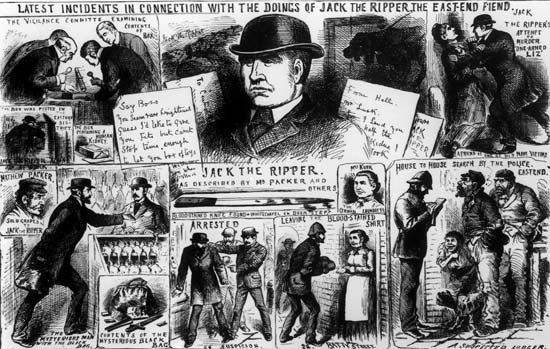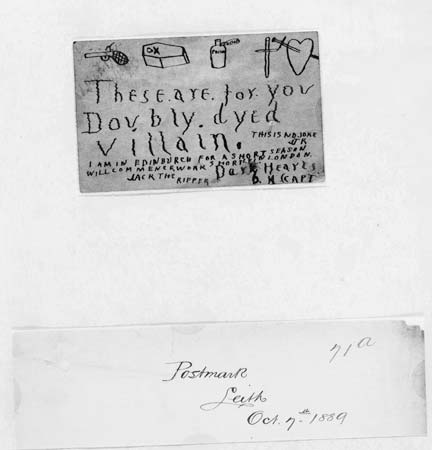Jack the Ripper
English murderer
 pseudonymous murderer of at least five women, all prostitutes, in or near the Whitechapel district of London's East End, from August 7 to November 10, 1888. It is one of the most famous unsolved mysteries of English crime.
pseudonymous murderer of at least five women, all prostitutes, in or near the Whitechapel district of London's East End, from August 7 to November 10, 1888. It is one of the most famous unsolved mysteries of English crime.
 All but one of Jack the Ripper's victims were killed while soliciting customers on the street. In each instance the victim's throat was cut, and the body was usually mutilated in a manner indicating that the murderer had at least some knowledge of human anatomy. On one occasion half of a human kidney, which may have been extracted from a murder victim, was mailed to the police. The authorities also received a series of taunting notes from a person calling himself Jack the Ripper and purporting to be the murderer. Strenuous and sometimes curious efforts were made to identify and trap the killer, all to no avail. A great public uproar over the failure to arrest the murderer was raised against the home secretary and the London police commissioner, who resigned soon afterward.
All but one of Jack the Ripper's victims were killed while soliciting customers on the street. In each instance the victim's throat was cut, and the body was usually mutilated in a manner indicating that the murderer had at least some knowledge of human anatomy. On one occasion half of a human kidney, which may have been extracted from a murder victim, was mailed to the police. The authorities also received a series of taunting notes from a person calling himself Jack the Ripper and purporting to be the murderer. Strenuous and sometimes curious efforts were made to identify and trap the killer, all to no avail. A great public uproar over the failure to arrest the murderer was raised against the home secretary and the London police commissioner, who resigned soon afterward.The case has retained its hold on the popular imagination, in part because known instances of serial murder were much rarer at the time than they are today. Jack the Ripper has provided themes for numerous literary and dramatic works. Perhaps the most notable was the horror novel The Lodger (1913; motion-picture versions, 1926, 1932, and 1944), by Marie Adelaide Lowndes (Lowndes, Marie Adelaide). More than 100 books about the case have been published, many of which offer conjectures as to the true identity of the murderer and the circumstances surrounding the crimes—including that the murders were part of an occult or Masonic plot and that the police were covering up for highly placed culprits, perhaps even members of the royal family. Many of these works, however, are based on fraudulent claims and documents. The most commonly cited suspects are Montague Druitt, a barrister and teacher with an interest in surgery who was said to be insane and who disappeared after the final murders and was later found dead; Michael Ostrog, a Russian criminal and physician who had been placed in an asylum because of his homicidal tendencies; and Aaron Kosminski, a Polish Jew and a resident of Whitechapel who was known to have a great animus toward women (particularly prostitutes) and who was hospitalized in an asylum several months after the last murder. Several notable Londoners of the era, such as the painter Walter Sickert (Sickert, Walter Richard) and the physician Sir William Gull (Gull, Sir William Withey, 1st Baronet), also have been subjects of such speculation. The murder sites have become the locus of a macabre tourist industry in London.
Additional Reading
Works examining the Jack the Ripper case include Maxim Jakubowski and Nathan Braund (eds.), The Mammoth Book of Jack the Ripper (1999); Stewart P. Evans and Keith Skinner, The Ultimate Jack the Ripper Companion: An Illustrated Encyclopedia (also published as The Ultimate Jack the Ripper Sourcebook: An Illustrated Encyclopedia, 2000); Stewart P. Evans and Paul Gainey, The Lodger: The Arrest and Escape of Jack the Ripper (1995; also published as Jack the Ripper: First American Serial Killer, 1996, reissued 1998); and Philip Sugden, The Complete History of Jack the Ripper, rev. ed. (1995).
- Messager, André
- Messali Hadj, Ahmed
- Messalina Valeria
- Messalla Corvinus, Marcus Valerius
- Messapic alphabet
- Messapic language
- Messapii
- Messene
- Messenger
- Messenia
- Messenia, Gulf of
- Messenian Wars
- Messerschmitt, Willy
- Messiaen, Olivier
- messiah
- Messier catalog
- Messier, Charles
- Messikomer, Jakob
- Messina
- Messina earthquake and tsunami
- Messina, Strait of
- Messinian Stage
- Messmer, Otto
- Messner, Reinhold
- Mesta